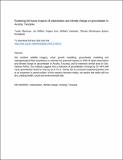Exploring the future impacts of urbanization and climate change on groundwater in Arusha, Tanzania
| dc.contributor.author | Olarinoye, Tunde | |
| dc.contributor.author | Foppen, Jan Willem | |
| dc.contributor.author | Veerbeek, William | |
| dc.contributor.author | Morienyane, Tlhoriso | |
| dc.contributor.author | Komakech, Hans | |
| dc.date.accessioned | 2020-06-29T08:27:41Z | |
| dc.date.available | 2020-06-29T08:27:41Z | |
| dc.date.issued | 2020-06-22 | |
| dc.identifier.uri | https://doi.org/10.1080/02508060.2020.1768724 | |
| dc.identifier.uri | https://dspace.nm-aist.ac.tz/handle/20.500.12479/806 | |
| dc.description | This research article published by Taylor & Francis Online, 2020 | en_US |
| dc.description.abstract | We combine satellite imagery, urban growth modelling, groundwater modelling and hydrogeological field expeditions to estimate the potential impacts in 2050 of rapid urbanization and climate change on groundwater in Arusha, Tanzania, and by extension similar areas in Sub-Saharan Africa. Our analysis suggests that a reduction of groundwater recharge by 30–44% will cause groundwater levels to drop by up to 75 m, mainly due to increased evapotranspiration and to an expansion in paved surface. If this scenario becomes reality, we predict that wells will run dry, creating health, social and environmental risks. | en_US |
| dc.language.iso | en | en_US |
| dc.publisher | Taylor & Francis Online | en_US |
| dc.subject | Urbanization | en_US |
| dc.subject | Climate change | en_US |
| dc.title | Exploring the future impacts of urbanization and climate change on groundwater in Arusha, Tanzania | en_US |

